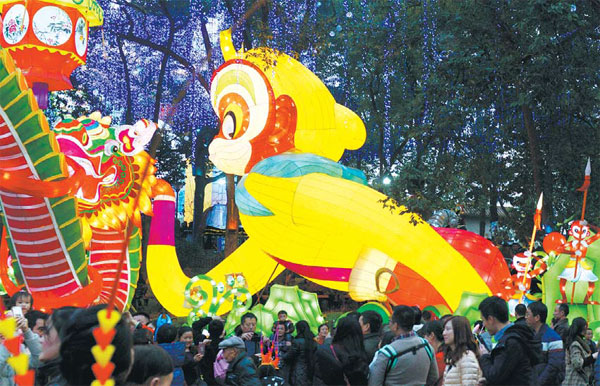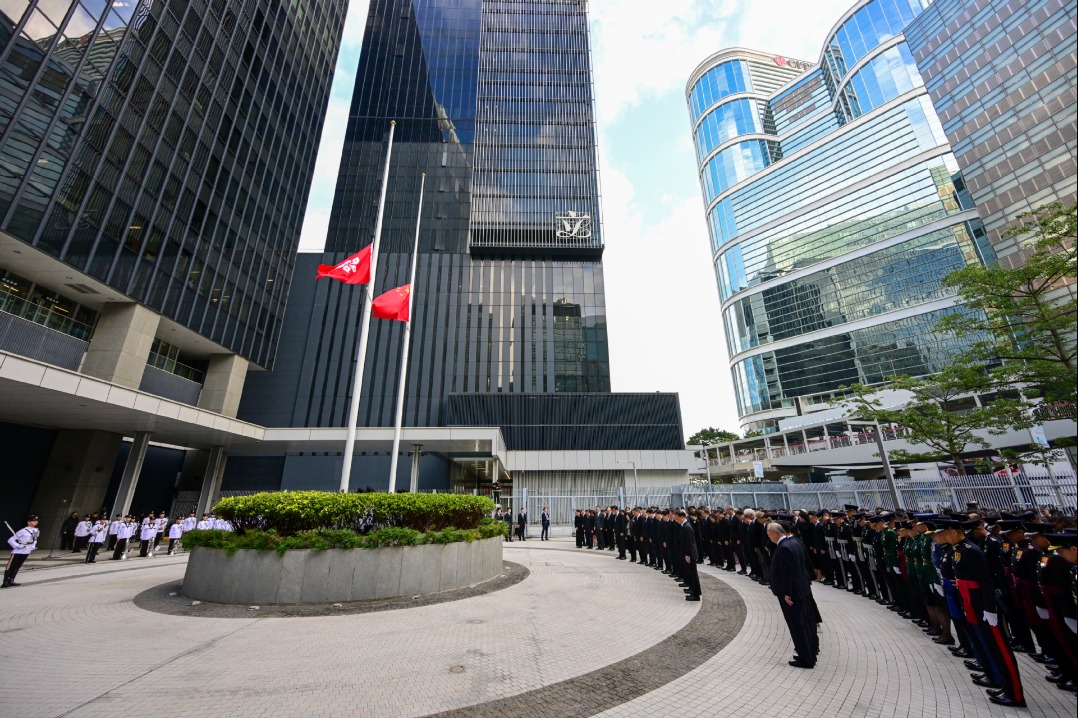Lighting the way to prosperity

After seeing its traditional salt-extraction industry die out, a small city in Southwest China set its sights on becoming the global capital for lanterns
"My grandpa sneers at today's lanterns. When he saw the annual lantern show in Zigong three years ago, he blurted out. 'Do you call those things lanterns?'" Yang Shiping says, laughing.
Yang is a third-generation lantern maker in Zigong, a city in the southwestern province of Sichuan. Known nationally as the Salt City, Zigong was a center of salt extraction for more than 2,000 years. At one time, it supplied one-third of all the salt consumed in China, although that was before cheaper sea and lake salts became more popular.
| From left: Visitors take a selfie at a Chinese lantern festival in Budapest, Hungary, which featured 45 works of art from Zigong, Sichuan province. Lantern versions of the Eiffel Tower and the Arc de Triomphe were highlights of this year's annual international lantern show in Zigong, which ended in March. Photos by Xinhua and Li Yang / China Daily |
| The annual lantern festival in Zigong, from January to March, attracts large numbers of visitors. Wei Xiaohao / China Daily |
The industry helped to nurture many businesses, including lantern making. Yang's grandfather Yang Quansheng, now in his 90s, started making lanterns in the 1920s, when he worked as an apprentice for several wealthy "salt families" who displayed the lanterns at an annual festival. Winning the champion's ribbon was an indication of power and status.
Some of the lanterns displayed in the annual show are produced by Yang Shiping's factory, Huilongtang Culture and Art Co, founded in 2012.
Bamboo, paper, silk, hemp rope, scissors, knives and candles were all Yang Quansheng needed to make a lantern. Today, his grandson, a fine arts graduate, uses a computer, light machinery, energy saving bulbs, steel and chemical fibers. His factory employs dozens of workers, who are divided into three groups: artistic innovation, machinery and general assembly.
"The biggest change has been in ideas," says Yang Shiping. "Grandpa is familiar with all the old legends and traditional stories that were the main source of creative ideas for the old lantern makers. But I must seek inspiration from a wider range of sources to cater to customers from around the world."
Huilongtang Culture sells its lanterns in Europe, North America, Asia and Oceania, and its annual sales revenue is about 20 million yuan ($2.9 million; 2.7 million euros).
Zigong is home to more than 400 lantern companies, which employ more than 70,000 of the city's 400,000 residents. Their lanterns are displayed in 500 major cities worldwide and the combined annual revenue is about 10 billion yuan, according to Liu Yongxiang, the city mayor.
The government has identified the lantern industry as an important driver of the local economy. The modern annual lantern show, which is held in a park downtown and is listed as intangible cultural heritage, has been staged in the first two months of the lunar calendar every year since 1964, although it was suspended during the "cultural revolution" (1966-76). The event attracts more than 2 million visitors from home and abroad and generates about 7 billion yuan in tourism revenue.
"Many people didn't expect an entertainment business to become a pillar industry after Zigong salt lost its competitiveness," says Cheng Longgang, a historian and deputy director of the city's salt museum. "The proportion of lantern workers is already comparable with that of salt workers during the peak of the trade.
"Likewise, 'salt gang food' - the pickled beef or vegetables given to long-distance drivers in the salt industry - is a unique Zigong attraction that has gained a reputation nationwide, even though the salt gang disappeared long ago."
As a child, Yang Shiping, 35, says he didn't want to be a lantern maker. His father, who learned the trade in the 1970s, suggested he should become a farmer because the salt industry was in decline and the powerful families had disappeared when the government acquired all the private businesses in the early '50s, which led local people to regard lantern making as a dying art.
In the mid-1960s, the central government relocated 22 state-owned enterprises, two institutes and a college to Zigong. The city was developed into a salt production center for the chemicals industry during the so-called third-tier construction campaign, a wave of industrial construction in remote inland areas designed to protect factories in the event of war.
During winter and spring, Yang Shiping's grandfather would work as a lantern maker for local enterprises and supplement his income by farming the rest of the year. During the market reforms of the '90s, many businesses that relied on government support in the planned economy went bankrupt or were relocated to Deyang, an industrial town near Chengdu, the provincial capital.
"The late '90s were the most difficult time for my family," Yang Shiping recalls. "After seeing some of the artisans go to the coastal cities to help make lanterns, I felt it was time I embraced my family legacy and started running my own factory."
Many lantern makers had similar experiences. In 2008, when they began to export their goods and organize overseas exhibitions, the international market posed many challenges for the old family and workshop business models. Almost every lantern enterprise paid a "tuition fee" when the government encouraged them to export their goods via the "going-out policy".
For Zhong Dongquan, general manager of Zhongyi Lantern Co, the memory of his first disastrous overseas operation - an exhibition in a small town in southern Germany - is still fresh in the mind.
"I lost 4 million yuan through poor publicity, a lack of understanding of German culture and bad weather. There was no support from the local government," he says. "I only calculated how many people lived within an hour's drive of the town, but the show was staged during the rainy season and the visitors didn't seem interested in traditional Chinese lanterns."
Zhong learned several lessons from that failure. He became more prudent in choosing locations, studied local people's interests carefully, and paid special attention to communicating with local governments.
That attention to detail has paid dividends and Zhongyi Lantern now has annual revenue of about 90 million yuan, with more than 80 percent generated through exports.
To explain why he focuses on the overseas market, Zhong pointed out that although the Chinese market is large, some companies always try to secure orders by cutting prices, which is not good for the healthy development of the industry.
"Zigong's lantern makers should continue the industry's fine, historic traditions. The old lantern makers built their competitiveness on innovation, skill and cooperation. Those old qualities still work well today," he says.
In 2012, a guild of lantern enterprises was established, and the city government is building the world's first lantern industry park.
Li Zhongwen, general manager of VYA Creative Lanterns, which started organizing exhibitions overseas in the late '90s, says the guild and the government should work more closely to regulate the development of the industry.
Li believes the implementation of the Belt and Road Initiative, which aims to promote international development and industrial cooperation, will provide a golden opportunity for the city's lantern makers to expand their businesses overseas.
Statistics from the Zigong government show the city's exports of cultural products, a large share of which come from lantern-related businesses, earned more than $13 million last year, up about 56 percent year-on-year. About 80 percent of the lanterns China exported last year came from Zigong.
"The Chinese lantern is an ideal symbol of culture and an auspicious messenger for good wishes and goodwill," Li says, adding that he hopes to transform the lantern show into a year-round Disneyland-style theme park, rather than just an annual event in the wake of the Chinese New Year holiday.
liyang@chinadaily.com.cn
(China Daily European Weekly 07/29/2016 page21)
Today's Top News
- Xi's article on CPC self-reform to be published
- Xi stresses improving long-term mechanisms for cyberspace governance
- Experts share ideas on advancing human rights
- Japan PM's remarks on Taiwan send severely wrong signal
- Key steps to boost RMB's intl standing highlighted
- Sustained fight against corruption urged
































